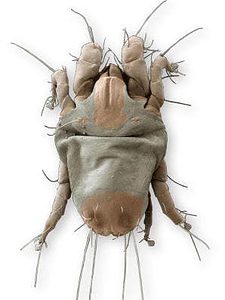A rather well rooted idea in evolutionary biology says that evolution itself is non-reversible. Simply put, once an organism has specialized certain traits, it can not return to its ancestral traits – this is commonly referred to as Dollo’s law. In a way, you could say that by looking at Dollo’s law, evolution isn’t ever wrong, and will always make the best decision. But that’s only one side of the coin, it would also mean that evolution isn’t at all that adaptable – which is a flawed statement to begin with.

In a ground-breaking research work, scientists at University of Michigan have for the first time demonstrated that Dollo’s law doesn’t apply to all organism after they performed a vast genetic survey of the common house dust mite. Their findings show that the dust mite evolved into its current free-living form after evolving from a parasitic ancestor, which in turn derived from a free-living organism. So, in the case of the dust mite at least, evolution wasn’t unidirectional. As you can imagine, the implications of this study are huge.
All our analyses conclusively demonstrated that house dust mites have abandoned a parasitic lifestyle, secondarily becoming free-living, and then speciated in several habitats, including human habitations,” according to Pavel Klimov and Barry OConnor of the U-M Department of Ecology and Evolutionary Biology.
The work required to reach these findings was painstaking, amounting to seven years. Some 700 mite species were collected for the study, which had the same five nuclear genes sequenced in each species. It’s rather ironic, however, that such a common pest, affecting 1.2 billion people in the world with allergies, might help scientists unravel and debunk some of the most firmly entrenched ideas.
[RELATED] Evolution is predictable after all
An arachnid and close relative of the spider, though only the size of a speck, the house mite has no less than 62 different published hypotheses arguing about whether it originated from a free-living ancestor or from a parasite. Yup, pest or not, the mite is really popular. Which one of the theories is true, though?
A law that can be broken
What better way to find out then testing each theory out, so obviously Klimov and OConnor proceeded in doing just so. Large scale DNA-sequencing was employed to build the evolutionary trees called phylogenies, in conjunction with highly complex statistical algorithms that tested each theory out. The output showed that house dust mites appear within a large lineage of parasitic mites, the Psoroptidia. Now, the latter type of mites are as parasitic as they come – they never leave their hosts, typically birds or mammals, and their immediate ancestors are yet again parasitic like psoroptic mange mites of livestock and the dog and cat ear mite.
As you can imagine, the researchers were terribly surprised. Again, basic evolutionary biology dictates that most of all a highly specialized parasites cannot return to the free-living lifestyle of their ancestors.
“Parasites can quickly evolve highly sophisticated mechanisms for host exploitation and can lose their ability to function away from the host body,” Klimov said. “They often experience degradation or loss of many genes because their functions are no longer required in a rich environment where hosts provide both living space and nutrients. Many researchers in the field perceive such specialization as evolutionarily irreversible.”
The researchers hypothesize that a combination of several characteristics of their parasitic ancestors played an important role in allowing them to abandon permanent parasitism: tolerance of low humidity, development of powerful digestive enzymes that allowed them to feed on skin and keratinous (containing the protein keratin, which is found in human hair and fingernails) materials, and low host specificity with frequent shifts to unrelated hosts.
Nest-inhabiting pyroglyphids then moved to human homes from birds or other mammals around dwellings, once with the advent of human civilization. Unfortunately, once the mites moved indoors, the potent digestive enzymes and other immune-response-triggering molecules they carry made them a major source of human allergies.
Our study is an example of how asking a purely academic question may result in broad practical applications,” said OConnor, a professor in the Department of Ecology and Evolutionary Biology and a curator of insects and arachnids at the U-M Museum of Zoology.. Knowing phylogenetic relationships of house dust mites may provide insights into allergenic properties of their immune-response-triggering proteins and the evolution of genes encoding allergens.
Findings were reported in the journal Systematic Biology.


